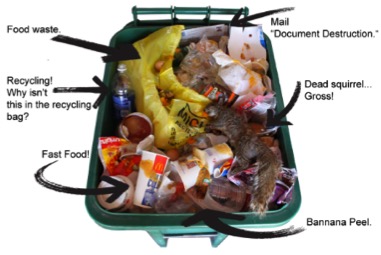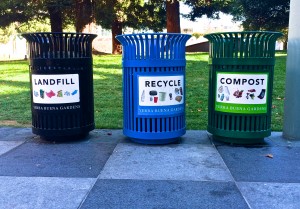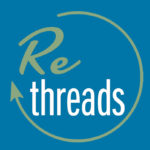 Little Miss Betty sat on her recycled parkbench
Little Miss Betty sat on her recycled parkbench
eating her organic parfait
Along came a mechanical green spider
and sat down beside her
and frightened Miss Betty away!
People have been asking whether the new machine at the Vanderlinde (VDL) recycling facility gets the thumbs up or the thumbs down from Betty. Here are the Cliff’s notes:
- We have to give it a thumb’s down overall, but it’s an improvement for non-recyclers
- It doesn’t achieve the 80% recycle rates of total waste, as was recently reported
- It doesn’t provide clean, high-quality reclaimed materials that can be sold for a decent price to manufacturers
The longer version…
Since early 2014, the VDL recycling facility for household waste has been down and out. The facility’s self-reported reclamation rate of 20% of recyclables dropped to an unknown number after a switch was made to manual hand sorting. No notice was given to households about the drastic change in their process, but Betty announced it on Facebook after hearing about the change first-hand from the DEQ (Dept of Environmental Quality) rep.
A lively discussion ensued.
Our response from Peter Vanderlinde, CEO of the facility, was the promise of a bigger and better machine that could reach recycling rates above 75% to be ready in February.
Could this be possible?
Well on Sunday, May 31st, we saw the newly installed big, loud, tech monster with our own eyes! Anne Bedarf of the Sustainable Packaging Coalition is a local expert on these types of facilities, having toured over 20 of them across the nation, and helped co-found CART with BWB, the Charlottesville Area Recycling Task Force. This was Betty’s second materials re-utilization facility (MRF) tour, and I was happy to see many Betty fans (one all the way from Harrisonburg) attend.
First, let us take you through the recycling process and try to provide some insight into how the new machine works:
Pretend for a moment that you are a piece of unwanted paper junk mail that just entered the facility about to take your recycling ride.
Your first stop is a duct-like vacuum that spits out the waste* onto a series of conveyor belts that sorts out the oversized bulky stuff. Then you enter a menacing, oversized metal tumbler/bag breaker, nicknamed “Jaws” because (according to the brochure) “no plastic bag survives it unopened.”** Time for the cardboard sorter. Next stop: fiber screens, then metal magnets, then an optical sorter – a robotic eye can detect different grades of plastic – and onto the aluminum silo. A worker then plucks you and places you in a suction tube for recovery.
All in all, there are 16 stops before the materials are put through a baler machine to make those large box-shaped bales of materials, smashed together to be sent off to manufacturers or processing facilities (mills and the like).
So the question Betties everywhere are asking: do we give the new machine the thumbs up or down?
Well…
- It’s certainly an impressive piece of human ingenuity.
- It’s definitely an improvement over what the facility had been doing.
- And, if you don’t recycle at all, this will be a step up for you.
BUT, if you are reading this, you obviously already care about recycling. So, here’s the scoop: If everything from dog poop in a plastic bag to rancid food and plastics are crushed into a collection truck, it’s going to be a stinky mess that results in lower recovery rates and a much lower quality of recovered materials than separating your recyclables (known as true “single stream,” which is available at McIntire and to city residents). It’s certainly not going to recycle 80% of the waste you create in your home (as Newsplex falsely reported this week). That is why these facilities are referred to as “dirty MRFs.”
And, ultimately, manufacturers don’t want these lower-quality materials because they are contaminated with any number of things. So, this dirty MRF isn’t accomplishing the goal of recycling, which is to create a closed-loop system in which goods or packaging are recovered and re-purposed so that manufacturing uses fewer virgin resources. Such a closed-loop system enables consumers like you and me to consume less by buying products that use recycled material or sustainable packaging (“Cradle-to-cradle” in McDonough lingo).
The fact is that many leading recycling organizations have come down against the all-in-one method of recycling used in a dirty MRF like VDL. To name a few:
-The Paper Recycling Coalition
–The Institute of Scrap Recycling Industries
–The Steel Recycling Institute
David Scheible, the CEO of Graphic Packaging, which is one of the biggest consumers of recovered fiber in the country, summarized the issues with dirty MRFs very well:
“The recycled paper industry, and tens of thousands of good paying jobs, is wholly dependent on a clean supply of recovered fiber… The ‘Dirty MRF’ system yields only minimal amounts of recyclable material, and much of what it does yield is often too contaminated to use. I am strongly opposed to this new modern approach to go back 20 years. Making boxes out of recycled paper that has been exposed to all types of consumer waste is simply not a good idea for a number of reasons…Recycling is the process of collecting and processing materials that would otherwise be land filled and turning them into new products, over and over again. Recycling is an essential part of the American economy and there is no reason to return to the ‘Mad Men’ era of throwing everything away.”
Scheible represents the Paper Recycling Coalition, which is a coalition of 10 companies that manufacture 100% recycled paperboard and container board for things like your cereal boxes. If you want to know more, check out the report published by Zero Waste Houston about how their all-in-one attempts are failing.
So Betty has to give the new “green machine” a thumbs down as a primary avenue for household recycling.
We believe that most people do care about recycling and, given the option of having recycling service paired with composting, would do the right thing. The “all-in-one” method can be used as a last ditch effort to capture recyclables. Check out Better World Betty and GreenBlue’s vision for recycling in our community.
 But for non-recycling households, the green machine is an important step up.
But for non-recycling households, the green machine is an important step up.
Now at this point, you may be wondering (as are we) why VDL doesn’t run this million dollar machine without the mixed waste but as a clean single-stream facility, which is the current national trend. Doing so would produce uncontaminated recyclables that would obtain a higher price at market. We’d love to see VDL work with haulers and the long range solid waste solutions committee about the viability of a clean MRF system. And we have heard that the facility has the capability of running lines of clean recyclables, but when we asked about it on Sunday they told us this would be phased out when the system is able to achieve high recycling rates. We will await the DEQ report a few months from now on the recycling rates (though these are self-reported and unverified).
Unfortunately, VDL is banking on a culture of convenience.
We want to be able to throw everything away without a care and have Dr. Seuss’ Fix-it-up Chappie magically put it into his high-tech machine and recycle it so that we can all go around with a star on our belly, feeling good that we’re “recycling.”
This green machine might be a part of the solution, but fittingly it seems to be throwing a big metal wrench into the idea of personal responsibility and the first “R”– reduce. If you don’t have to think about what you’re throwing away, you’re likely not going to make steps to reduce your waste. And, we should be mindful about what resources we use and the waste we create.
As always, thanks for caring!
Betty
*We use the term waste instead of recylables because we are imagining you live in the County and have an all-in-one system
**NOTE: Plastic bags are an environmental scourge, which is why Betty encourages you to make use of reuseable bags. And please DON’T bag your recyclables — this absolutely does not make a difference in the process.





Comments on this entry are closed.